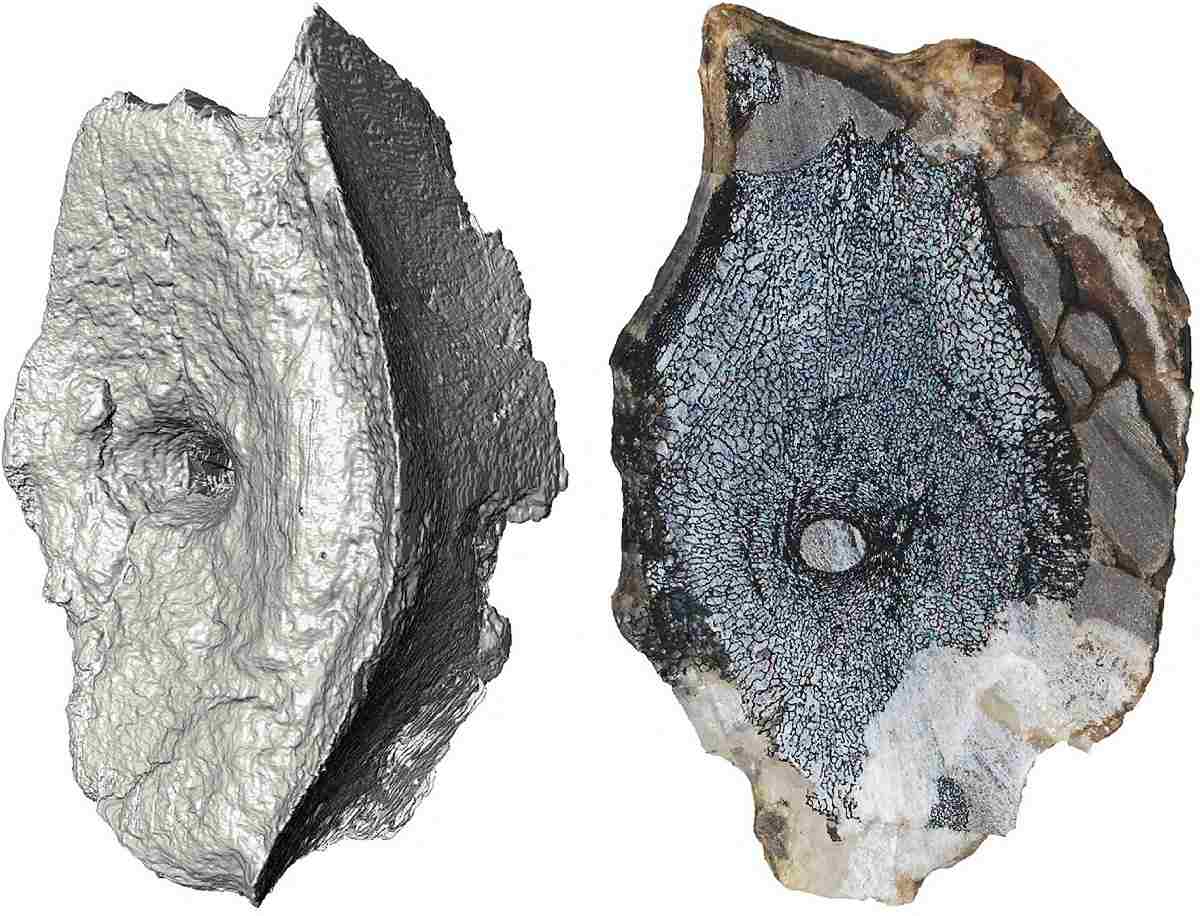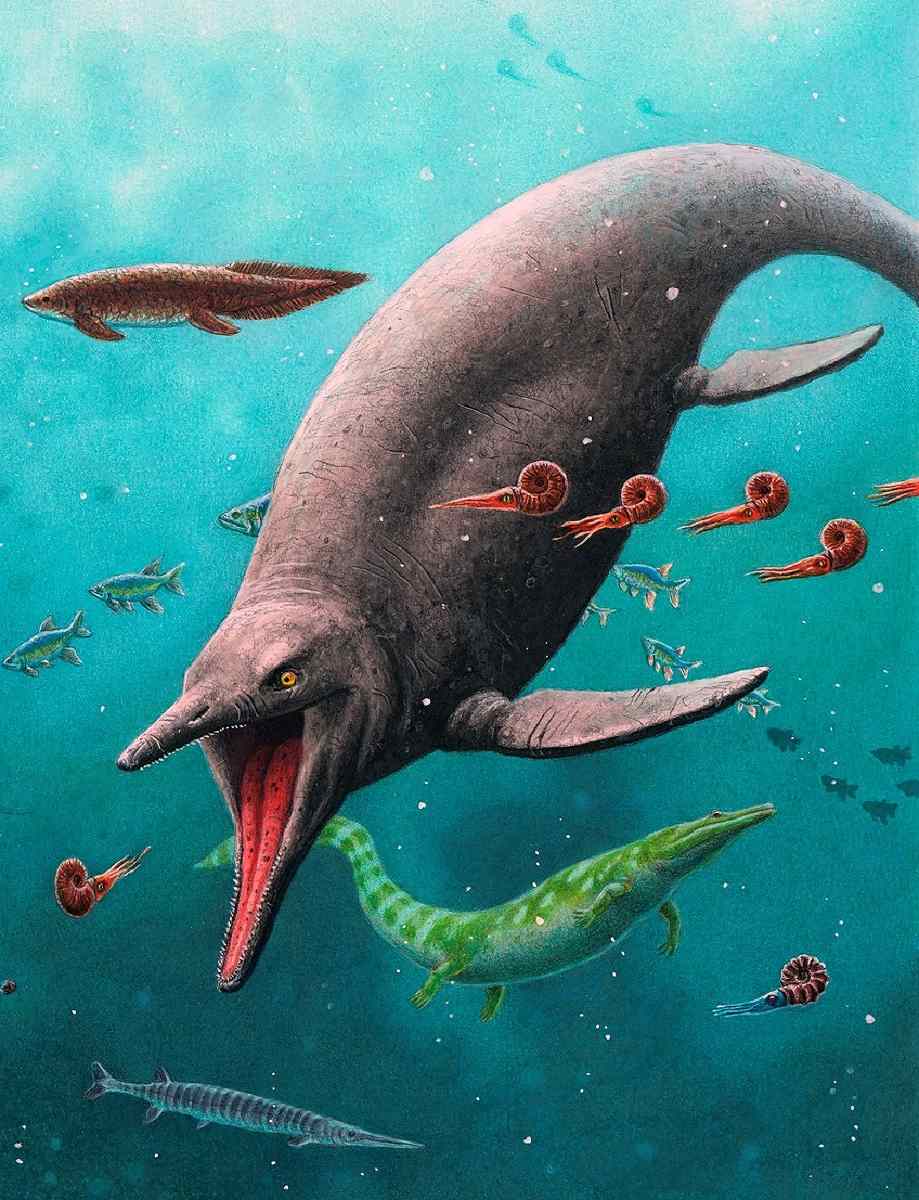
The internal bone structure of vertebrae from the earliest-known Ichthyosaur is seen in this computed tomography image and cross-section, obtained on March 14.
12:18 JST, April 13, 2023
WASHINGTON (Reuters) — Ichthyosaurs were a successful group of marine reptiles that prospered during the age of dinosaurs, some reaching up to around 21 meters long — exceeded in size in the history of Earth’s oceans only by the largest of the whales.
But their origins have been a bit mysterious. Fossils dating to about 250 million years ago unearthed in a harsh and remote locale — Norway’s Arctic island of Spitsbergen — are now providing surprising insight into the rise of ichthyosaurs.
Researchers said they found remains of the earliest-known ichthyosaur, which lived approximately 2 million years after Earth’s worst mass extinction that ended the Permian Period, wiping out roughly 90% of the planet’s species amid massive Siberian volcanism. The 11 tail vertebrae discovered indicate that the animal was about 3 meters long, making it a top predator.

The earliest-known Ichthyosaur, along with other marine creatures in the 250-million-year-old ecosystem found on the remote Arctic island of Spitsbergen, Norway, is seen in this undated image obtained on March 14.
Like whales, which are mammals, and the various other reptile lineages that have inhabited Earth’s oceans, ichthyosaurs evolved from ancestors that walked on land and underwent a land-to-sea transition.
The researchers had thought any ichthyosaur living 250 million years ago would have been a primitive form, not far removed from its land-living forerunners. The fossils showed this one, which has not yet been given a scientific name, was quite advanced anatomically.
“The real surprise was that after a suite of geochemical, computerized micro-tomographic and bone microstructural analyses, the vertebrae turned out to be from a highly advanced, fast-growing, probably warm-blooded, large-bodied at around 3 meters long, and fully oceanic ichthyosaur,” said Benjamin Kear, curator of vertebrate paleontology at Uppsala University’s Museum of Evolution in Sweden and lead author of the research published in the journal Current Biology.
“The implications of this discovery are manifold, but most importantly indicate that the long-anticipated transitional ichthyosaur ancestor must have appeared much earlier than previously suspected,” Kear added.
In light of this discovery, it may be that ichthyosaur origins predated the mass extinction event by up to perhaps 20 million years, Kear said. The Triassic Period that followed the mass extinction was the opening act of the age of dinosaurs, though the oldest-known dinosaurs did not appear until about 230 million years ago.
The site where the fossils were found is a classic Arctic landscape with high snow-capped mountains along the coast of a deep fjord. The fossils were exposed along a river channel fed by snow melt that cuts through rock layers that were once mud at the bottom of the sea. While today there are polar bears and beluga whales at Spitsbergen, 250 million years ago the sea there would have been teeming with fish, sharks, shelled squid-like ammonoids and crocodile-like marine amphibians called temnospondyls.
The mass extinction shook up land and marine ecosystems and opened opportunities for new species to fill ecological roles vacated by extinct creatures. Ichthyosaurs quickly became dominant and endured until about 90 million years ago.
Many ichthyosaurs looked like dolphins, except with vertical rather than horizontal tail flukes. Others resembled large whales. The biggest included Shastasaurus, at about 20 meters. They ate fish and squid. Fossils show ichthyosaurs giving live birth to their young.
Until now, the oldest-known member of the ichthyosaur lineage was a 40-centimeter-long creature called Cartorhynchus that lived 248 million years ago in China.
Researchers in recent decades have identified the earliest forms of whales, including one called Ambulocetus, dubbed the “walking whale” because it retained limbs that enabled it to still move around on land.
“Most excitingly, the mysterious ‘walking’ ichthyosaur ancestor is undoubtedly still out there waiting to be uncovered,” Kear said. “Only now we will have to start looking in even older rocks, which is exactly what we will be doing on our next fossil-hunting trip to Spitsbergen this summer.”
"Science & Nature" POPULAR ARTICLE
-

Genome Study Reveals Milestone in History of Cat Domestication
-

Big Leap in Quest to Get to Bottom of Climate Ice Mystery
-

Security Camera Footage Vulnerable to Outside Access; Investigation Finds 3,000 Pieces Exposed Online
-

Paws on Parade: Nairobi’s Dogs Dazzle at ‘Pawchella’
-

Japan Set to Participate in EU’s R&D Framework, Aims to Boost Cooperation in Tech, Energy
JN ACCESS RANKING
-

Keidanren Chairman Yoshinobu Tsutsui Visits Kashiwazaki-Kariwa Nuclear Power Plant; Inspects New Emergency Safety System
-

Tokyo Economic Security Forum to Hold Inaugural Meeting Amid Tense Global Environment
-

Imports of Rare Earths from China Facing Delays, May Be Caused by Deterioration of Japan-China Relations
-

University of Tokyo Professor Discusses Japanese Economic Security in Interview Ahead of Forum
-

Japan Pulls out of Vietnam Nuclear Project, Complicating Hanoi’s Power Plans






















